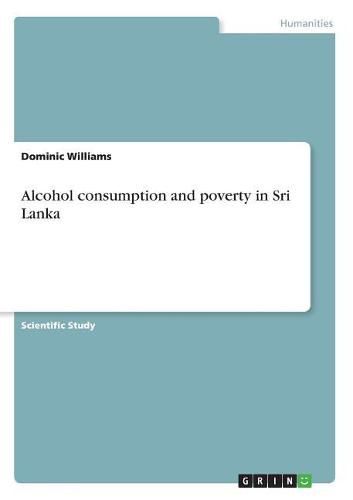Readings Newsletter
Become a Readings Member to make your shopping experience even easier.
Sign in or sign up for free!
You’re not far away from qualifying for FREE standard shipping within Australia
You’ve qualified for FREE standard shipping within Australia
The cart is loading…






This title is printed to order. This book may have been self-published. If so, we cannot guarantee the quality of the content. In the main most books will have gone through the editing process however some may not. We therefore suggest that you be aware of this before ordering this book. If in doubt check either the author or publisher’s details as we are unable to accept any returns unless they are faulty. Please contact us if you have any questions.
Scientific Study from the year 2017 in the subject Sociology - Miscellaneous, language: English, abstract: Sri Lanka’s alcohol production and consumption have grown rapidly and more than 75 percent of the government’s revenue, from alcohol taxes and levies, comes from arrack production. Hard liquor consumption is relatively high in Sri Lanka compared with the global trend, as well. Illegal alcohol (mainly known as Kasippu) consumption in Sri Lanka is popular among people because it is cheaper. In the second half of this paper, various definitions on poverty and its measurements are briefly discussed in order to emphasise that the term ‘poverty’ is not merely a lack of income, and to broaden the term’s connotations. This chapter also serves to highlight the fact that poverty is a complex phenomenon with various social, health and economical influences. Following a survey of definitions of poverty and description of poverty measurements, this chapter provides an overview of global trends in poverty and poverty in Sri Lanka. Although the aggregate poverty rates declined in the world, the number of poor people has increased in South Asia and Sub-Saharan Africa continents. Compared to the other South Asian countries Sri Lanka has had better living conditions. There is a declining trend in poverty in Sri Lanka. However, the income inequality has grown in Sri Lanka in recent years as it has been in the South Asian region.
$9.00 standard shipping within Australia
FREE standard shipping within Australia for orders over $100.00
Express & International shipping calculated at checkout
This title is printed to order. This book may have been self-published. If so, we cannot guarantee the quality of the content. In the main most books will have gone through the editing process however some may not. We therefore suggest that you be aware of this before ordering this book. If in doubt check either the author or publisher’s details as we are unable to accept any returns unless they are faulty. Please contact us if you have any questions.
Scientific Study from the year 2017 in the subject Sociology - Miscellaneous, language: English, abstract: Sri Lanka’s alcohol production and consumption have grown rapidly and more than 75 percent of the government’s revenue, from alcohol taxes and levies, comes from arrack production. Hard liquor consumption is relatively high in Sri Lanka compared with the global trend, as well. Illegal alcohol (mainly known as Kasippu) consumption in Sri Lanka is popular among people because it is cheaper. In the second half of this paper, various definitions on poverty and its measurements are briefly discussed in order to emphasise that the term ‘poverty’ is not merely a lack of income, and to broaden the term’s connotations. This chapter also serves to highlight the fact that poverty is a complex phenomenon with various social, health and economical influences. Following a survey of definitions of poverty and description of poverty measurements, this chapter provides an overview of global trends in poverty and poverty in Sri Lanka. Although the aggregate poverty rates declined in the world, the number of poor people has increased in South Asia and Sub-Saharan Africa continents. Compared to the other South Asian countries Sri Lanka has had better living conditions. There is a declining trend in poverty in Sri Lanka. However, the income inequality has grown in Sri Lanka in recent years as it has been in the South Asian region.